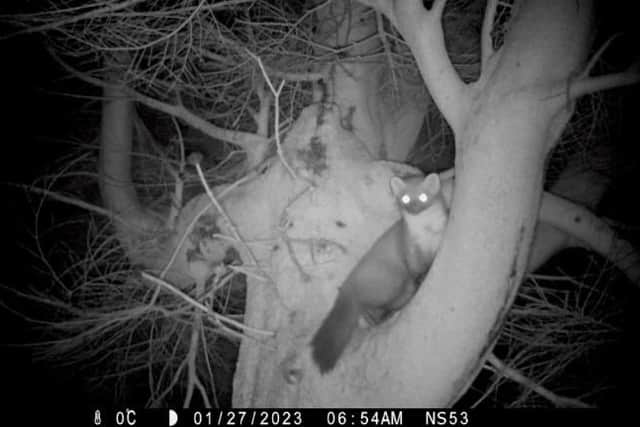Rare pine marten from Dalby Forest in the North York Moors is confirmed to have reached Spurn Point on the Yorkshire coast after 60-mile journey
Nature Spy staff’s camera traps first recorded a male nicknamed ‘Two Dots’ in Dalby Forest, a Forestry England site in the North York Moors National Park, in August 2022 as part of investigations to establish whether a population of pine martens had returned to the area after a long period without sightings.
Their first footage was captured at Dalby in 2017 – and at the time was the first live record of the animals’ presence in 35 years, other than a skull found in 1993. Since then, three different individuals have been caught on camera, having most likely ranged from the Kielder Forest population in Northumberland.
Advertisement
Hide AdAdvertisement
Hide AdTwo Dots, named after the markings on his bib, was filmed roaming across a wide area of the forest, and is thought to have explored nearby Cropton Forest too, most likely because he did not face competition for territory from other males and was struggling to find a mate.


Yet in March 2023, Two Dots disappeared and there were no further recordings of him in Dalby. Nature Spy knew he had moved on – but they were amazed to discover where he had ended up.
In late April, they received unexpected reports from the Yorkshire Wildlife Trust, who run the nature reserve at Spurn Point on the Humber Estuary. A birdwatcher, Paul Willoughby, had not only seen a pine marten, but taken photographs of it hunting rabbits in daylight.
The photographs clearly matched Two Dots’ bib pattern from the camera trap footage, and the identification was confirmed.
Advertisement
Hide AdAdvertisement
Hide AdThe Yorkshire Wildlife Trust’s Rosie Jaques said: “Imagine our surprise earlier this year when reports of a rare mammal - more at home in remote woodlands - began to reach us at Spurn National Nature Reserve.


"Spurn is one of the best places in Yorkshire to witness the spring and autumn bird migrations, so we're quite used to some wonderful and rare sightings. But when the first report of a pine marten on the peninsula reached us at the Discovery Centre in April, we'll be honest - we were a little sceptical.
"Pine martens are mostly a woodland-dwelling species and Spurn is a sandy peninsula dominated by dunes and scrub. However, reports of the Spurn pine marten seen near the visitor centre and also at the tip of the peninsula continued. As a nature reserve popular with photographers and wildlife watchers, it was only a matter of time before we saw the evidence too
"The first photos came thanks to Spurn Bird Observatory’s Paul Willoughby, whose amazing images confirmed that the reports were true, and with some investigations, revealed the epic journey that this individual took.
Advertisement
Hide AdAdvertisement
Hide Ad"Over the next few weeks, the pine marten was seen several times along the length of the reserve. This 4.2-mile journey from Spurn Bird Observatory’s ranger building at the base of Spurn to the the tip of the point also includes over 1,200 meters (0.75 miles) of beach and a hazardous wash over that separates the end of the peninsula from the mainland at high tide.
"Pine martens have large territories so the area covered at Spurn was quite typical - but until we knew more about the real journey this individual had taken, it looked to be making some significant and regular excursions around Spurn.
“Following the sightings, we sought advice and information from our friends at Yorkshire Pine Marten project who track and record pine martens in North Yorkshire. Working with SBOT and NatureSpy's Pine Marten project, therefore, we have been able to identify where the pine marten came from.
"That's an amazing journey - whether looking for food, a home, new territory or a mate - we can only imagine the route he took through pockets of woodland, over fields and roads that led him to reach Spurn. Our pine marten was last seen at Spurn in June, but we're keeping an eye out to see if it returns or pops up somewhere else after another epic journey.”
